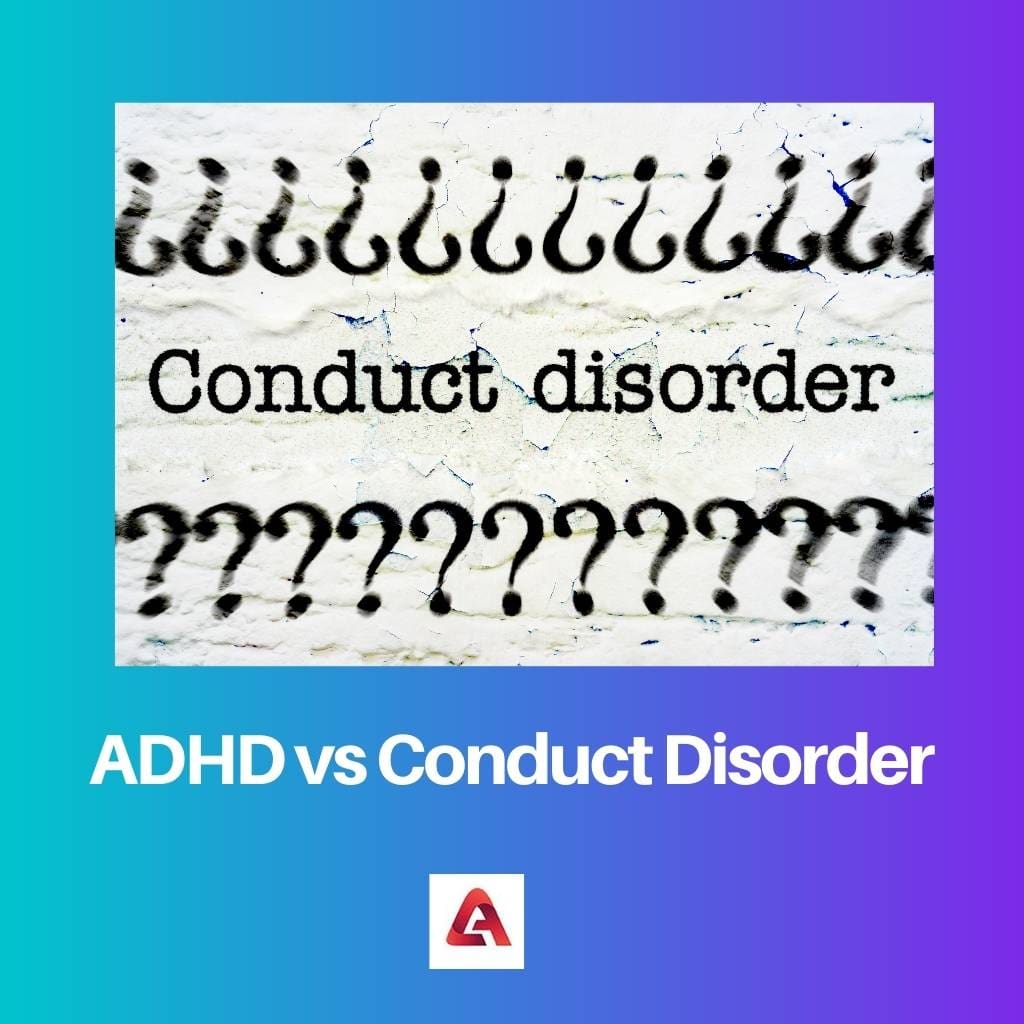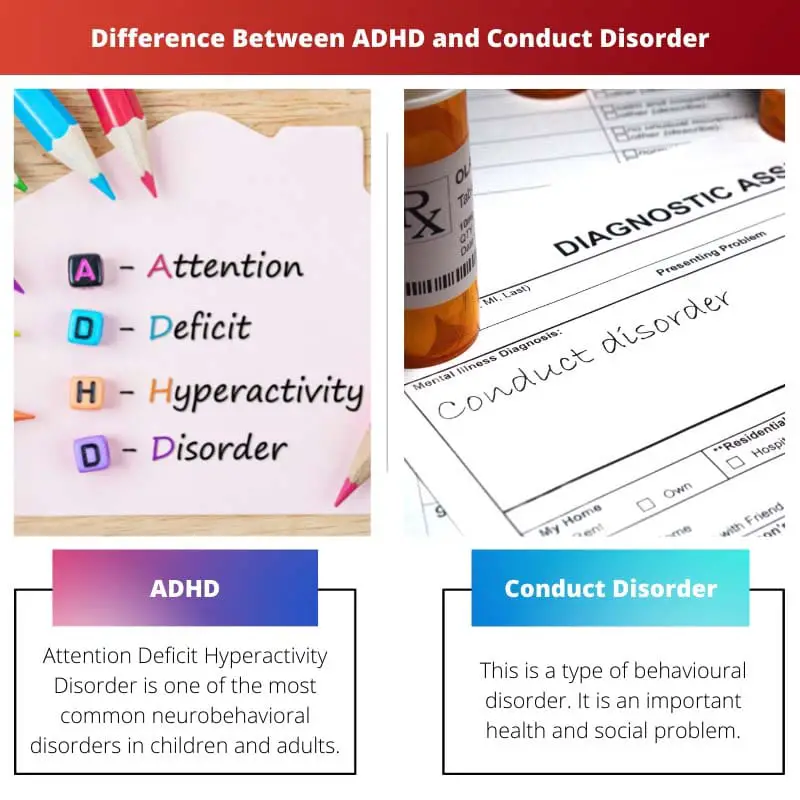The acronym ADHD stands for Attention Deficit Hyperactivity Disorder. This disorder is prevalent in children and adults.
This primarily affects the activity of the brain. Several symptoms are visible in the child having this particular disorder.
There are various treatments, methods and practices to help children and adults with this disorder.
Conduct Disorder is developed when the individual is a child, and it can develop into adulthood.
It is a behavioural type of disorder that particularly affects the child’s behavioural response. They do not prefer to follow the protocols set by anyone, causing physical harm and being cruel to animals and humans.
They are most likely to have difficulty in relationships with anyone in the future.
Key Takeaways
- ADHD is characterized by inattention, hyperactivity, and impulsivity, while conduct disorder involves aggressive, rule-breaking, and antisocial behavior.
- ADHD symptoms appear before age 12, while conduct disorder develops during late childhood or early adolescence.
- Treatment for ADHD includes medication and behavioral therapy, while conduct disorder treatment involves therapy, parent training, and social skills development.
ADHD vs Conduct Disorder
The difference between ADHD and Conduct Disorder is that ADHD affects brain activity, and Conduct Disorder affects the behavioural activity of an individual. In some medical cases, children with ADHD are also viable to develop a Conduct Disorder. ADHD disorder is chronic, but conduct disorder has a genetic influence.

Attention Deficit Hyperactivity Disorder is also called Attention Deficit Disorder.
It is a chronic condition that is prone to affect the attention span of the individual. It can contribute to an individual’s low self-esteem, relationships with peers, inability to focus on a single task, processing information slowly, trouble following instructions, difficulty in sitting still, and so much more. It is a very common disorder that can be treated and not completely cured.
Conduct Disorder is an important disorder that is behavioural and emotional and can affect children, teens and adults. They have a pattern of behaviour which they display is disruptive and violent.
They can cause physical harm, breaching of rules, have temper tantrums and be sexually active at a very young age.
Comparison Table
| Parameters of comparison | ADHD | Conduct Disorder |
|---|---|---|
| Type of Disorder | It is a chronic disorder | It is a genetically influenced disorder |
| Symptoms | It causes aggression, irritability, inability to pay attention, repetition of words, difficulty in focusing | These individuals are prone to violating rules, bullying, physical assault, run away from home, do drugs, alcohol |
| In Children | The symptoms of inattention and hyperactive-impulsive behaviour start before the age of 12. | As a child, they can be seen causing temper tantrums, arguing, deliberately annoying and actively not following rules |
| In Adults | The symptoms can be from mild to severe; some may think that just doing everyday tasks is difficult and nothing with ADHD. Stress, poor sleep are other symptoms | Difficulty with handling a job and not maintaining relationships are difficult. In adults, it is hard as Antisocial Personality Disorder as well |
What is ADHD?
Attention Deficit Hyperactivity Disorder is one of the most common neurobehavioral disorders in children and adults. It is a chronic disorder with prominent symptoms. It begins when the individual is a child and then goes to adulthood.
This disorder can be treated and not cured. Treatment of medication and talk therapy will be given to these individuals.
There are three types of ADHD: The first is the inattentive type, the hyperactive-impulsive type and the combination type.
Their behaviour can be categorized in three ways: not paying attention: being distracted, poor concentration skills and organisation skills. Secondly, impulsivity and thirdly comes hyperactivity with constant fidgeting.
Research shows that an estimated 4℅ to 12% of worldwide children are affected by ADHD, and 4% to 5% of adults and college students have this disorder.
When it comes to children, boys are more affected than girls, and in adults, an equal number of men and women are affected.
The treatments for ADHD is behavioural therapy, training the parents, speech therapy and medications.

What is Conduct Disorder?
This is a type of behavioural disorder. It is an important health and social problem.
Conduct Disorder is a very common psychiatric disorder around the globe among 5% of individuals, and it is still rising.
These children are given a diagnosis.
These individuals show severe antisocial behaviour, which comprises tantrums, physical and verbal aggression, stealing, lying, violation of rules and other people’s rights.
These are caused and also triggered by ineffective parenting, and poor disciplinary practices in the home. They are also caused by genetic influence.
The symptoms can be divided into four categories as aggressive behaviour, destructive behaviour, deceitful behaviour and severe violation of rules. The causes for this disorder include biological, genetic, environmental, psychological and social causes.
There are specifically trained health professionals and psychiatrists to treat these mental illnesses. Psychotherapy supports the individual to control and express their anger in more appropriate ways.
Cognitive behavioural therapy is performed on these individuals to help their skills, anger management, impulse control and their moral reasoning skills.

Main Differences Between ADHD and Conduct Disorder
- ADHD and Conduct disorder differ in their origins. ADHD is a chronic disorder, whereas Conduct Disorder is caused by genetic influence, the environment that the child grows in, psychological abuse and parental rejection.
- ADHD is a neurobehavioral disorder, and Conduct Disorder is a psychiatric disorder.
- Conduct Disorder happens when the child shows symptoms such as not abiding by the protocols, tantrums, running away from home, getting influenced by substances such as drugs and alcohol, and bullying, but ADHD-affected children show symptoms such as hyperactivity, constant fidgeting and inattention. ADHD-diagnosed children can develop Conduct Disorder. One out of four children can get it.
- Individuals with ADHD struggle to organise thoughts and grasp new information, whereas individuals with Conductive Disorder have behavioural changes that are aggressive, harmful and violating.

- https://bmcpsychiatry.biomedcentral.com/articles/10.1186/1471-244x-11-57
- https://ajp.psychiatryonline.org/doi/abs/10.1176/ajp.156.10.1515

The three types of ADHD and their distinct behavior patterns offer valuable insights into the manifestation of this disorder in individuals.
The chronic nature of ADHD and the methods of treatment available underscore the importance of early detection and intervention for affected individuals.
The distinction between ADHD and Conduct Disorder in terms of their impact on brain activity versus behavioral activity is paramount for understanding these conditions.
The comparison table of symptoms and behavioral patterns between ADHD and Conduct Disorder provides a comprehensive overview of their differences.
The social implications and prevalence rates of Conduct Disorder highlight the need for effective societal interventions and support systems.
The prevalence rates and behavioral manifestations of Conduct Disorder require a multifaceted approach that addresses genetic, environmental, and social influences.
Developing holistic interventions that consider the interconnected factors influencing Conduct Disorder is essential for effective management and prevention.
The link between ineffective parenting, disciplinary practices, and the onset of Conduct Disorder emphasizes the need for family-based interventions and support.
The prevalence rates and gender-specific differences in ADHD and Conduct Disorder highlight the need for targeted awareness campaigns and early intervention strategies.
Addressing the unique challenges posed by ADHD and Conduct Disorder through tailored interventions can significantly improve the quality of life for affected individuals.
The impact of ADHD and Conduct Disorder on individuals’ social and emotional well-being emphasizes the need for comprehensive support systems and societal awareness.
Increasing awareness and understanding of ADHD and Conduct Disorder within communities can foster a more inclusive and empathetic environment for affected individuals.
The impact of ADHD and Conduct Disorder on children and adults underscores the necessity of tailored treatment approaches that consider age-specific symptoms and challenges.
The behavioral and genetic distinctions between ADHD and Conduct Disorder call for personalized interventions that address the unique needs of affected individuals.
Adopting a holistic approach to treating ADHD and Conduct Disorder can improve outcomes and facilitate better long-term management of these conditions.
Research indicates that ADHD affects an estimated 4% to 12% of children worldwide, with similar prevalence rates in adults and college students.
The gender-based differences in the prevalence of ADHD between children and adults are quite interesting and warrant further investigation.
Conduct Disorder is a significant health and social problem, with severe antisocial behavior such as tantrums, aggression, stealing, and violations of rules and others’ rights.
It’s important to understand that effective parenting and proper disciplinary practices at home play a crucial role in preventing conduct disorder.
The rising prevalence of conduct disorder around the globe is concerning and calls for more awareness and intervention.
ADHD is a neurobehavioral disorder that is prevalent in children and adults. It can be treated but not cured. Different treatment options like medication and talk therapy are available.
The distinction between the inattentive type, hyperactive-impulsive type, and the combination type of ADHD is quite informative.
I agree with you. ADHD poses challenges but with the right support and treatment, individuals affected can manage it effectively.
The distinction in symptoms and developmental timelines between ADHD and Conduct Disorder provides important insights into these conditions.
The behavioral categorization and impact on relationships for adults with ADHD and Conduct Disorder is noteworthy.
Understanding the genetic influences on Conduct Disorder sheds light on the multifaceted nature of this behavioral disorder.